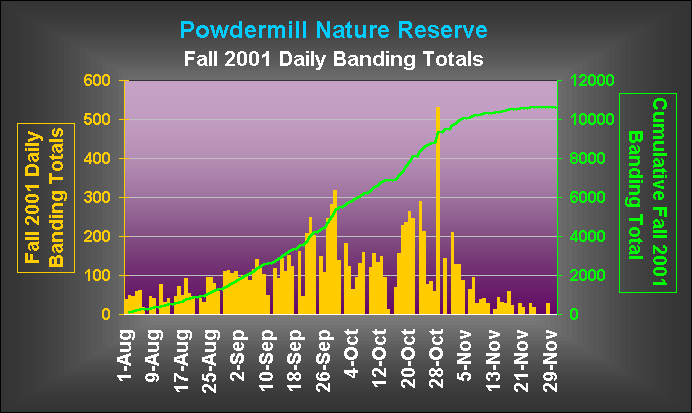
| How'd We Do? | Species Diversity | Highs and Lows | Banding Effort | Fall Trends | Species Totals |
The bird-banding program at Powdermill Nature Reserve, the 2,000 acre biological stationof Carnegie Museum of Natural History located in the Laurel Highlands region of southwestern Pennsylvania, was in operation on 100 out of a possible 122 days during the fall 2001 season (August through November). Total banding effort for the season (21,640 net-hours) was the third highest ever, reflecting both favorable weather conditions for banding and more than the usual amount of assistance from enthusiastic and hard-working volunteers and interns. The result was a very interesting and productive banding season. For that reason we would like to begin by acknowledging everyone who helped this fall.
THANKS!
We were fortunate, as always, to have regular participation from a dedicated corps of dependable, long-term volunteers: Mary Helen Chiodo, Carroll Labarthe, and Carole Shanahan. In addition, several local college students (some of whom were summer field interns) helped right up until their fall terms began and on many weekends and breaks thereafter. For dedicating themselves to their studies and the banding, we heartily thank Steve Graff (Indiana University of Pennsylvania), Brian Jones (Penn State University--Dubois), and Annie Lindsay (Grove City College). Two of our banding interns from previous seasons, Amy Cunkelman and Adrienne Leppold, returned to help with banding at Powdermill again this fall after one or more seasons of exciting field biology adventures in Alaska! Importantly, we also thank several sets of understanding parents who have supported (e.g., by feeding the cat, providing access to transportation, forgiving the foregoing of some family obligations, etc!) and thereby encouraged the passion that their sons and daughters have found in the study of birds and ecology. We are also grateful for the occasional help (sometimes on an emergency, "all hands on deck" basis!) from Jamie Fischer, Darlene Madarish, Jack and Karyl Merchant and their nine year old daughter, Jessica, Powdermill's Resident Director, Dr. Joseph F. Merritt, Jami Paul, and Martin Schaefer.
And the list goes on...once again, our good friend and very talented fellow bander from Maryland, Jim Gruber, gave us the benefit of his energy and banding expertise for a week in August. Fränzi Nievergelt, a visiting doctoral student and "ringer" from Switzerland deserves special mention for tirelessly lending a hand with net opening, net closing, and everything in between almost daily from mid-August to early October. While helping us a great deal, Fränzi somehow managed to get work done for her doctoral research (which is what she came here to do in the first place!)--taking comparative measurements of closely related North American birds that either do or don't forage frequently in conifers (e.g., Red-breasted vs. White-breasted nuthatches). Another visitor, Diane Pick was a tremendous help scribing our banding records every day during one of the heaviest two-week periods of the season (late September to early October)--without her steadfast assistance we certainly could not have banded so many birds (almost 2,000 during her stay) so efficiently. Fellow banders, Mark and Julie Shieldcastle, took a bander's holiday, helping us for several days in November shortly after closing their banding station for the season at Black Swamp Bird Observatory in Ohio.
Finally, for supporting and facilitating our efforts in many ways beyond direct help with the banding, we again thank Powdermill's Director, Dr. Joseph F. Merritt, and also the station's talented maintenance crew, Gilbertand Albert Lenhart and Lloyd Moore. As always, we feel very lucky to have a highly skilled data entry operator at Carnegie Museum's Section of Birds, Marilyn Niedermeier, who painstakingly enters, checks and double checks all of our banding records, and who is responsible for generating banding schedules and filling data requests.
So,
with all this help....
Notwithstanding
a very few negative results, it
was a positively
great fall banding season at Powdermill!
Overall, we banded 10,637 birds,
which is a record high total
for the season (previous high was 10,129 in fall 1982). We banded
100 or more birds on 45 days, including 100-200 on 31 days, 200-300 on
12 days, 300-400 on one day, and >400 on another day, 28
October, when we logged our third highest
daily banding total (531)
in the 40-year history of our banding program. We banded 15%
of our cumulative total during August,
36% in September,
38% in October,
and 11% in November.
Our busiest periods were the last ten days in both September and October
(see graph below).

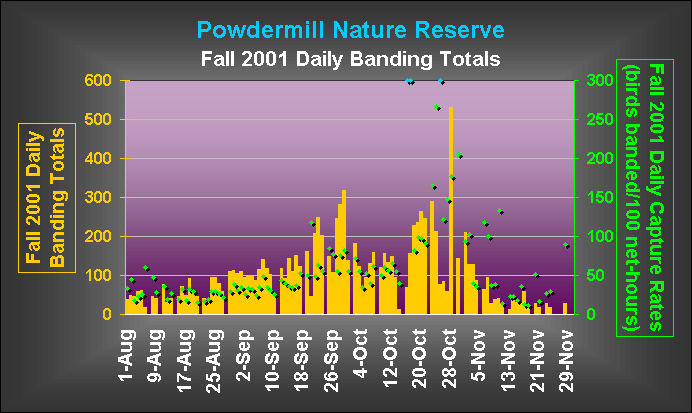
Species diversity
in our banding sample also was above average this fall. The 112
species banded ties for fourth highest--our record high species count,
115, was set in fall 1991. The vast majority of species banded this
fall (62%) had been recorded by the end of August,
with another 27% making their first appearances in September,
10% in October,
and just two new species (1%) added in November.
No new species were added to the cumulative Powdermill fall banding list,
which stands at 170 (166 species plus two hybrid forms and two recognized
subspecies), but an American Bittern caught
on October 4 was just our third ever to band.

Banding totals for no less than a dozen species constituted new record highs for Powdermill, with a variety of migratory categories represented: permanent residents (Eastern Tufted Titmouse), irruptive northern species (Red-breasted Nuthatch and Purple Finch), short distance migrants (Winter Wren, American Goldfinch), and, best represented of all, Nearctic-Neoptropical migrants ("Traill's"Flycatcher, Veery, Wood Thrush, Black-and-white Warbler, Black-throated Green Warbler, Magnolia Warbler, Northern Waterthrush, and Hooded Warbler). In most of these cases the former record high was just edged out by one to a few birds, but the 120 WOTH banded this fall doubled our previous record high total, 523 MAWAs was 140 (40%) more than our previous high set last fall, and 189 HOWAs exceeded our former record count by 39 (26%). In many of these cases, these record totals are in line with significant positive fall trends at Powdermill across more than 40 years.
Only one species, Cape May Warbler (eight banded), was caught in record low numbers this fall. In addition, conspicuous "misses" this fall included Eastern Screech Owl, Olive-sided Flycatcher, Golden-winged Warbler, Worm-eating Warbler, Yellow-breasted Chat, Rusty Blackbird, Red-winged Blackbird, and Common Grackle. We banded up to 11 OSFL in 21 out of the first 25 years of the Powdermill banding program, but no more than two in just four out of the last fifteen years (and none in the last eight fall seasons). Similarly, we banded up to 19 YBCH in 28 out the first 30 years, but no more than two in four of the the last ten years (and none in each of the last three falls). Finally, this is only the third fall season out of forty that we have failed to catch even a single GWWA, and it is the very first time we have "missed" banding a RUBL.
As always, a handful of species makes up a large proportion of our total catch at any season. Nine out of ten of the species on this fall's"top ten" list of most commonly banded birds are also on the overall (1962-2000) fall top ten list for Powdermill. The top ten species this fall contributed 56% to the overall fall banding total, which is a higher percentage than usual (undoubtedly due to the execptionally high totals this fall for Magnolia Warbler, White-throated Sparrow, American Goldfinch, and Purple Finch).
Fall banding effort
at Powdermill has been variable across years--the number of nets used and/or
the number of hours of net operation on a given day, as well as the number
of banding days during any given fall season, being determined, in part,
by prevailing weather conditions and the availability and/or level of field
assistance. In the graph below, although variation in banding effort
shows no increasing or decreasing trend across all years, there appears
to be a rather close corespondence between banding effort and banding totals
(the slight positive trend for banding totals
is statistically significant: R2
= 0.15, P < 0.05).

The apparent relationship
between effort and totals is confirmed when we examine the correlation
between these two variables (graph below). Note that the banding
total for fall 2001 (yellow symbol)
is much greater than what would be predicted from the overall correlation
between effort and totals.
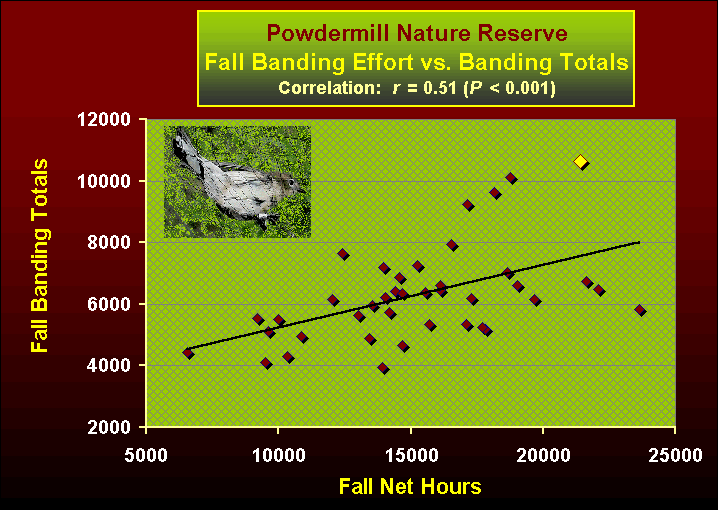
Importantly, the record high overall banding total this fall was matched by a comparatively very large banding effort this fall (our third highest), such that the calculated capture rate this season (49.2 birds/100 net-hours), although above average, was nowhere near the record high 67.6 birds/100 net-hours recorded in 1962. In that year we had one of our lowest fall banding totals but also put out the lowest effort of any fall season. Clearly, in examining possible long-term trends in fall banding data, it is necessary to account for variation in banding effort across years.
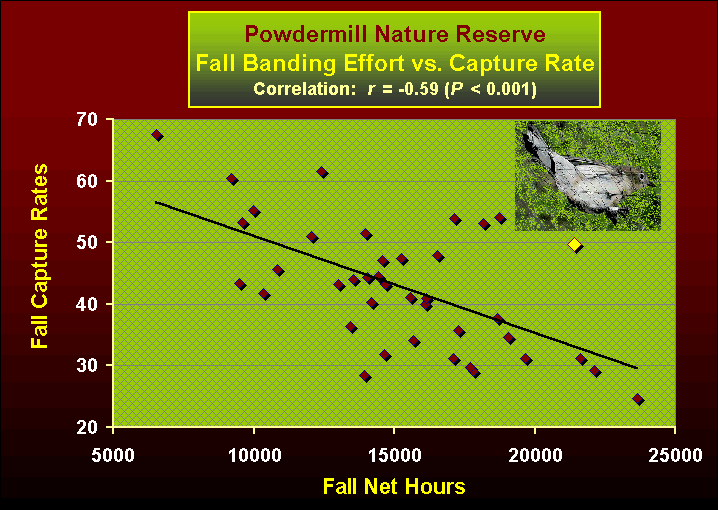
Unlike the significant increasing
trend observed for raw banding totals, when annual variation in effort
is taken into account, there is no significant trend in overall capture
rate (all species combined) across fall seasons at Powdermill (see
graph below).
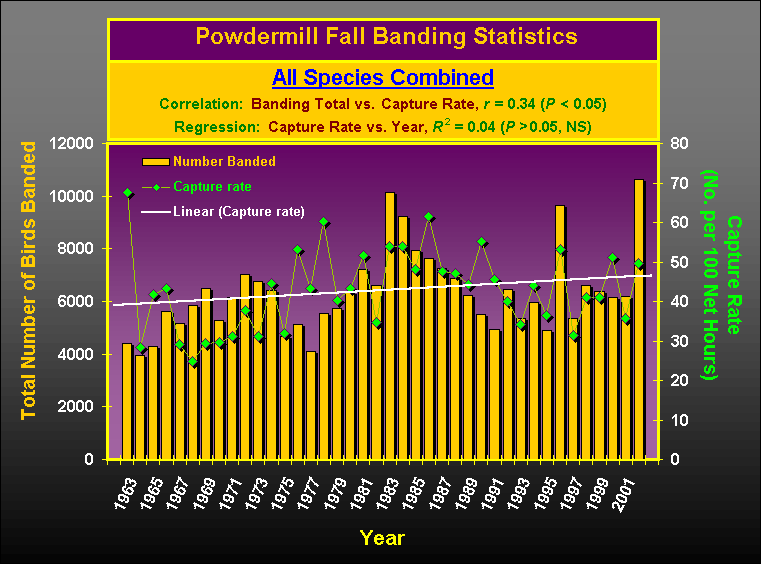
In the links below (Species Totals Summaries), Powdermill banding totals (original captures only) from this fall are compared to averages, standard deviations, maxima, and minima for the previous 40 fall seasons (1962-2000). Similar statistics for each of the four component decades that the banding program has been in operation were published here previously (see Fall 2000 Summary). For selected species we have again graphed the annual fall totals from 1962-2001, and these are accessible through links in the summary table. In previous graphical summaries, however, we presented only raw data, uncorrected for effort, and without any statistical analyses. For this summary, we present both raw and effort-corrected data (note that in the species analyses, capture rates are expressed as birds per 1,000 net-hours, rather than birds per 100 net-hours, in order to give larger, more easily interpretable values). In general, correlations between fall banding totals and fall capture rates for individual species (ave. r = 0.88; range, 0.51-0.99) were much higher than the overall combined-species correlation (r = 0.34). We used simple linear regression statistics to provisionally examine these data for possible long-term trends in our fall capture rates for selected species (as examples, Hooded Warbler and Field Sparrow are shown below). Out of 82 species examined in this way, the majority (42) shows no significant linear trend, 14 have declining trends, and 26 increased significantly across years (click here for a list by trend category with links to charts).
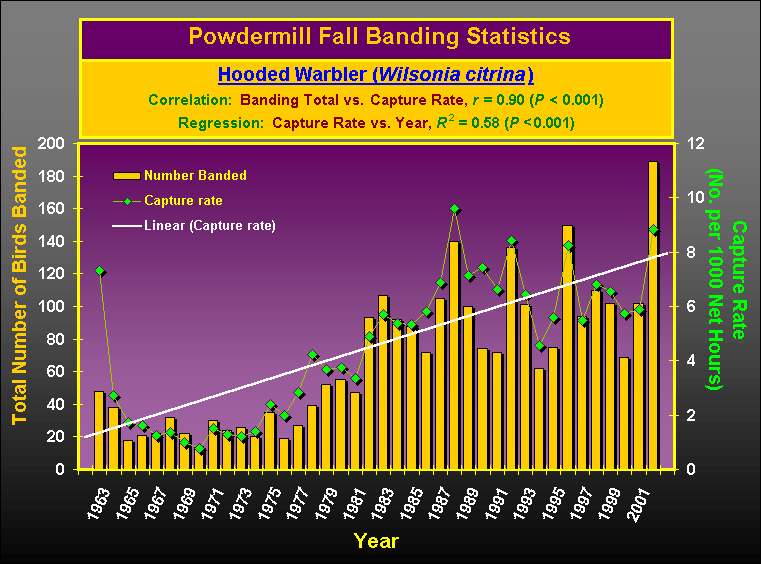

As we have said here before, apparent trends in our fall banding data, even when the data have been corrected for effort and subjected to rudimentary statistical analysis, must always be interpreted with caution. Simply put, when we assess trends in the number of birds of a given species caught during fall migration, we need to know what it is that we are measuring.
Many of the trends in the provisional analysis of 40 years of fall banding data presented here are similar to results based on more sophisticated analyses of Powdermill data spanning fewer than half as many years data. These earlier data, and comparable data from another long-term banding station located in coastal Massachusetts, were analyzed in a collaborative study with scientists at Manoment Center for Conservation Sciences (formerly, Manomet Bird Observatory) and published in connection with a Smithsonian sponsored symposium in 1989 on the Ecology and Conservation of Neotropical Migrant Landbirds (Hagan, III, et al. 1992. Long-term changes in migratory landbirds in the northeastern United States: evidence from migration capture data. Pp. 115-130 in the aforementioned volume, Smithsonian Institution Press, Washington, D.C.).
In general, results of that study showed that while migration sampling likely can provide information on breeding bird population trends, there are important geographical and sampling considerations. For example, most long-term breeding population trends are based on driving surveys and, therefore, have a roadside bias; migration sampling has no such bias, but may be affected by factors such as weather and habitat change at the banding site. Also, in making correlations, it is important to compare migration banding samples with breeding trends for appropriate geographical areas (both with respect to location and scale), i.e., it is important to know the likely breeding ground origins for birds caught in migration. In theses earlier analyses, the researchers could only guess at the likely origins for migrant birds at Powdermill (e.g., based on geographical proximity), and they had no way of knowing if the source for migrants changed from one year to the next or from the beginning to the end of a given migration season, for that matter.
Importantly, recent technological advances involving genetic and stable isotope analyses of feather material collected from live birds holds a great deal of promise for the eventual, range-wide mapping of migratory routes used by different populations of a given species. In addition, satellite transmitters will no doubt one day soon be miniaturized to the point that they can be attached to songbirds whose individual migration routes can then be traced with fantastic precision! Eventually, information about breeding abundance and reproductive success for different populations will be able to be directly compared with population estimates based on banding samples taken along the migratory routes for those populations.
When this important new information becomes available, extensive historical datasets like those collected at Powdermill, and a handful of other long-term banding stations, will take on new and added significance. Furthermore, continual migration banding will almost certainly become one of the most effective and cost-efficient means for accurately monitoring bird populations and fostering their conservation.
Without doubt, this is a very exciting time of discovery for all of us who are interested in the ecology and conservation of migratory birds!